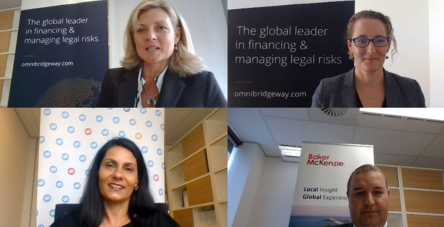In-house counsel insights into dispute finance

- Author:
- Tania Sulan
- Managing Director - Transformation - Australia
Many in-house counsel would consider using dispute finance for commercial claims according to a survey conducted by Omni Bridgeway at the 2020 Association of Corporate Counsel (ACC) in-house Legal Virtual Conference, with the inability to afford litigation being the main factor influencing their decision.
Omni Bridgeway led a panel discussion at the Conference on how dispute finance can help in-house legal teams unlock legal assets while managing litigation risk, and audience polling during the discussion gave an insight into numerous in-house perspectives on these issues. The panel was facilitated by Omni Bridgeway’s Leanne Meyer who spoke with Tania Sulan, Omni Bridgeway’s Chief Investment Officer for Australia and New Zealand, Tasha Smithies - Senior Litigation Counsel at Network Ten and Paul Forbes - Disputes Partner at Baker McKenzie.
Cost exposure biggest issue when convincing board to litigate
Speaking to an audience from a variety of industries in the private and public sector, Leanne pointed out that regardless of the type of organisation, many of the challenges are the same for in-house counsel: to manage costs and generate revenues.
Providing the in-house perspective, Tasha concurred that cost exposure was the biggest issue in convincing the board to pursue litigation - not just the legal spend but the risk of adverse legal costs if the litigation is unsuccessful. She observed, however, that by choosing not to litigate, the company could miss out on strategic litigation which aligns with the board’s objectives. In some circumstances, even without litigation finance, the risk of a costly legal dispute can be outweighed by the benefits a successful claim could bring to the organisation.
Tania summarised how dispute finance works and can help to overcome some of these cost issues, in that:
- Dispute finance is non-recourse, so the client does not have to pay if the case is unsuccessful.
- The financier can cover all or part of the legal expenses, based on the client’s needs. Each arrangement is tailor made to the circumstances of the client and the case.
- Working capital can also be provided to cover business operational costs during a dispute.
- The financier only receives a return on its investment if the case is successful.
Costs pressure was a shared theme across survey respondents, with 50% indicating that inadequate capital to pursue litigation was the main factor driving their decision to use, consider using or recommending third party dispute finance. Other high-ranking factors included:
- the ability to deploy capital elsewhere while still pursuing legal claims;
- the desire to transfer adverse costs to a funder; and
- being able to draw on the expertise of a third party financier’s team at no extra cost
Using dispute finance to preserve existing litigation
While 57% of survey respondents said the current economic climate has not impacted their inclination to pursue a legal claim, Paul warned that it could impact a company’s ability to continue to fund existing litigation if a company’s revenues are down, thus making it more challenging to meet legal costs. Dispute finance is available at any stage of litigation, not just at the genesis of a claim, and gives clients the ability to continue to pursue the claim.
Key funder attributes
Paul, Tasha, and survey respondents also offered their top tips for in-house counsel to look out for when engaging a funder:
- Subject matter expertise and track record are the top-ranked attributes - expertise and experience are what matter most to in-house counsel
- The funder needs to be flexible in responding to clients’ needs and accommodating differing risk appetites
- Pragmatism is very important- the funder needs to understand a client’s business and what drives it as it can have a big impact on settlement or how proceedings are run strategically
- Capital adequacy (a funder’s financial resources) is also very important – knowing the funder can support you all the way.
Watch the full webinar here: